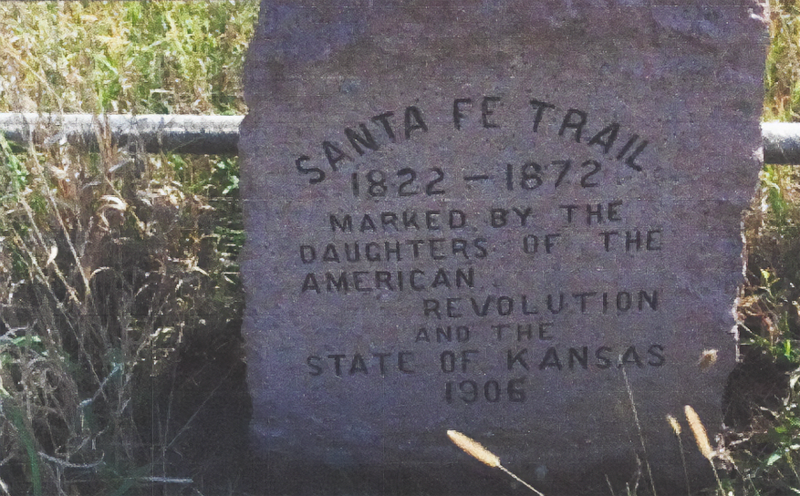
By LUCIE KRISMAN
Kansas Reflector
This time last year, Lynda Fort got cabin fever.
As a way to pass the time, she started driving along the Santa Fe Trail, beginning in Marion County and ending up in Rice County. It took three days of driving, and in that time she sought out all 67 of the markers in the southwest district – which begins in Wichita and ends near the borders of Colorado and Oklahoma – of the trail.
These boulders were originally placed by the Daughters of the American Revolution in 1906. When tourists or students from nearby schools visit, Fort said, the markers serve as a useful tool for learning about its history.
“That makes it very important,” she said. “It’s part of the history and development that unfortunately is going to be lost in history if we don’t keep emphasis on it.”

These kinds of efforts across Kansas, as well as the other five states the Santa Fe Trail runs through, have preserved the trail and its history for 200 years. The trail reached its bicentennial this year, and historian Steve Schmidt said the parts of the trail that remain visible mark an important and unique aspect of United States history.
“Even in Kansas, there’s several areas where you can see extensive remnants of it,” Schmidt said. “I’d just really hate to see those remnants lost. I just think it’s a national treasure, sort of like the Black Hills or Mount Rushmore or the Washington Monument.”
The trail span six states, for approximately 870 miles, and most of it today sits on private land. Steve and Glenda Schmidt have worked for more than 20 years to preserve the parts that go through their Marion County property. Schmidt said the main way to preserve the trail is to remove new types of trees that injure prairie vegetation, but the property has also been added to the National Register of Historic Places.
Ensuring long-term preservation on private property isn’t easy, Schmidt said, and the trail’s historic status doesn’t necessarily prevent future owners from destroying the land. But it might give them pause.
“It’s hard to force your wishes on the future owners,” Schmidt said. “As our attorney says, the law does not like people controlling things from the grave.”
Schmidt previously served as the president of the Cottonwood Crossing Chapter of the Santa Fe Trail Association before becoming the chapter’s secretary and treasurer, as well as serving on numerous committees and the STFA board of directors. There’s lots of collaboration on the national level to protect the trail, STFA President Larry Short said, but the individual work that the local chapters do is crucial.
“Our local chapters are our faces in the area and our boots on the ground,” Short said.
The STFA’s 12 local chapters are on the lookout for news about possible destruction to the trail and go through the financial and legal steps of marking the trail. Kansas DAR members were the first from any state to begin placing markers, in 1902. The DAR-placed markers were ordered refurbished at the beginning of 2021, and the STFA teamed up with other historic organizations this fall to create an interactive way for people to find and document them.

These kind of interactions make the markers important, Fort said. As a Capstone project, she relocated and repaired six DAR markers in five of the Southwest District’s Kansas counties. Funding for the project came from Dodge City’s Mariah Fund, which is largely used for nonprofit tourism efforts in Kansas.
Fort is a lifelong member of the DAR, but before she moved to Mulbane, Kansas in 2017, she owned a bed and breakfast hundreds of miles away in Ulysses. There, she watched birdwatchers from far and wide visit to glimpse rare birds. The satisfaction of marking different types of bird sightings kept birdwatchers coming back, just like tourists use the markers to track their progress on the trail.
“In tourism, all of these different things are kept alive because they bring outsiders into our state,” Fort said.
Commemoration efforts have been underway this year in Kansas. The Quivira and Council Grove chapters have led an ongoing series of events in conjunction with the 200th anniversary including shows, program screenings and a scavenger hunt.
In the trail’s next 200 years, Short hopes to see it continue as a draw for students from nearby schools. The anniversary is a commemoration, not a celebration, he said, and teaching future generations about the Santa Fe Trail and what it meant for the country’s history will continue to be crucial.
“If we don’t know our history, we don’t know our future,” he said. “We can learn a lot from our past, both good and negative. That’s our basis for being what we are today; it comes from what we were.”
. . .
Lucie Krisman graduated from the William Allen White School of Journalism at the University of Kansas in the spring of 2021. She has reported on beats that include local government, business, and arts and culture. Before writing for the Pitch and the Lawrence Times, she previously worked as a City Hall reporter for the Eudora Times, an initiative out of the KU journalism school to provide community news to Eudora through student reporters. During the COVID-19 pandemic, she also remotely covered stories for the North Dakota Newspaper Association that were distributed to newspapers across the state. She has received awards from the Kansas Press Association for business, education and government reporting.
The above story is republished with permission from Kansas Reflector.





